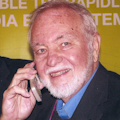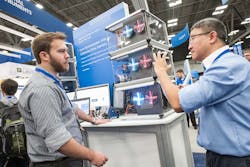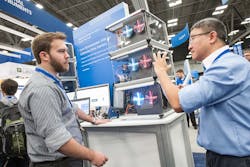I have been to many conferences over the years as an editor and writer for Electronic Design. I have attended the big ones—CES, CTIA, and Mobile World Congress, to name three—as well as some smaller ones like GlobeComm, DAC, and the test and power shows. But none of these is quite as good as NIWeek.
NIWeek, in case you do not know, is National Instruments’ annual event for introducing new products and bringing together the company’s large customer and support vendor bases. It may not be the largest conference, but it’s fun, educational, and diverse. Quality, not quantity.
This year’s NIWeek (the 22nd) was the 10th I’d attended. Also notable for NI in 2016: It’s the company’s 40th anniversary, as well as the 30th anniversary of its flagship software product, LabVIEW. Like usual, this year’s NIWeek was held the first week in August during Austin’s normal 100+ degree days. The attendance of mostly engineers was estimated to be about 5,700. This year NI offered more than 235 diversified educational tech sessions.
These sessions and the exhibits are divided up by specialties, or summits—those being academic; aerospace and defense; 5G and other wireless; automated test systems; data acquisition; embedded systems; the Internet of Things (IoT); and vision. There were more than 125 exhibitors. The largest, of course, was NI, showing off its massive, diverse product lines. I focused on the communications and wireless stuff.
One panel of interest, hosted by NI’s EVP Eric Starkloff, was about the hot topic of the year: the IoT. The experts represented Analog Devices, Cisco, Oak Ridge National Labs, Optimal Plus, and Xilinx. I had hoped to get a better sense of what is happening in this burgeoning field, but I am not sure I did. The whole discussion was pretty vague and general. What I did learn was that the big issues remain the same: lack of standards, security, and how to handle the big data being generated.
One of the biggest segments is the industrial IoT. More progress seems to have been made here as so many of the applications just seem to make sense. The 3GPP’s NB-IoT narrowband LTE standard seems to be a winner. 5G wireless, when it appears in 2020 and beyond, will apparently carry much of the forthcoming data load. Some problems yet to solve are related to protocols and data formats, as well who will control IoT in the enterprise: IT or a new IoT hierarchy?
Starkloff wrapped up the panel by asking their advice about what engineering education should be these days. There was general consensus that students should concentrate on learning how to learn, and universities should make the curricula more interdisciplinary.
I also had a good briefing on 5G with one of NI’s wireless executives, James Kimery. He mentioned that the 3GPP should have an initial draft of the standard by late next year. He indicated that the modulation may end up being plain old OFDM rather one of the newer waveforms being researched.
Kimery also thought that the NB-IoT version of LTE could well be one of the key wireless standards, especially for industrial IoT. 5G is still a work in progress with a long way to a final standard in 2020. Massive MIMO, up to 128 antennas, will play a major role.
NI’s spectacular keynote presentations are where the company showcases its new products. There are too many new products to discuss here, but several are worth mentioning. The first is a new version of LabVIEW. The new version adds something called channel wires that are designed to simplify complex communications between parallel sections of code, improving code readability and reducing development time.
Another major announcement was NI’s MIMO Application Framework. MIMO is a key part in almost all new wireless technology like 5G. As the number of MIMO channels increase, it becomes ever more difficult to design and test such systems. The LabVIEW Communications MIMO Application Framework lets engineers create new algorithms and evaluate custom IP to solve design problems with massive MIMO configurations. The MIMO Framework is scalable from 4 to 128 antennas.
Also mentioned multiple times during the keynote presentations was NI’s second generation Vector Signal Transceiver (VST) designated as PXIe-5840. Introduced in July, the VST is a 6.5-GHz vector signal generator combined with a 6.5-GHz vector signal analyzer and a programmable FPGA in a two-slot PXI module. With a 1-GHz bandwidth and EVM performance of up to -50 dB, the new VST is well suited to test multichannel systems. The VST can replace test instruments at half the cost and still speed up design or production test.
If you have not attended an NIWeek event, make plans for next year. Save up. The 2017 conference will be held in May rather than August, when it is considerably cooler. It is a worthwhile educational experience.
About the Author

Lou Frenzel Blog
Communications Technology
Click here to find more of Lou's articles on Electronic Design.


